Ayushman Bharat – A giant leap towards Universal Health
Steeped in stiff challenges as it may be at the moment, but Ayushman Bharat is now a reality. Universal Health is no longer a distant dream. Ayushman Bharat would make available healthcare services to those marginalized people who need it the most. The scheme will provide financial protection to 10.74 crore poor, deprived rural families and identified occupational categories of urban workers’ families as per the latest Socio-Economic Caste Census (SECC) data. Around 50 crore beneficiaries would get a benefit cover of Rs. 500,000 per family per year.
The scheme is world’s largest government funded health care both in terms of size and magnitude. The sheer volume itself raises a lot of expectations among millions of deprived people unable to meet their healthcare needs and fall into debt trap. But the scheme also gives rise to apprehensions about its successful implementation, given the current level of healthcare infrastructure and manpower availability.
In order to gauge the real issues surrounding the implementation of this mammoth scheme, the Birla Institute of Management Technology (BIMTECH) organized a round-table discussion on Ayushman Bharat – National Health Protection Mission – Opportunities & Challenges. The round-table was organized at the India Habitat Centre, Delhi, on September 22nd 2018.
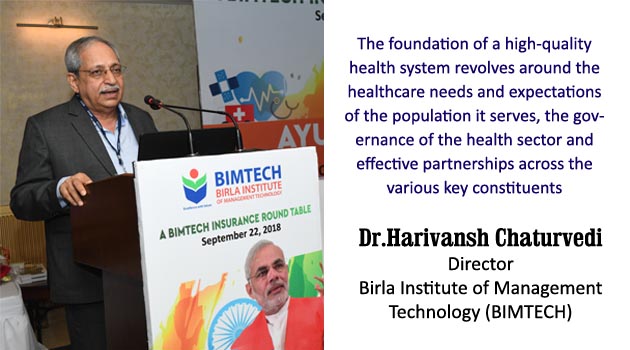 The thinking behind the round table, said Prof. (Dr) H Chaturvedi, Director, BIMTECH, was to build a consensus around myriads of issues ailing the healthcare system in India. The views of the thought leaders and captains of the healthcare industry participating in the round table would help us in making a blueprint as to how each one of us can contribute towards the vision of Ayushman Bharat. “The foundation of a high-quality health system revolves around the healthcare needs and expectations of the population it serves, the governance of the health sector and effective partnerships across the various key constituents”, he reiterated.
The Scheme aims to adopt a continuum of holistic approach to healthcare comprising two principal pillars – creation of 1.5 lakh health and wellness centers across India and successful implementation of Pradhan Mantri Jan Arogya yojana.
The thinking behind the round table, said Prof. (Dr) H Chaturvedi, Director, BIMTECH, was to build a consensus around myriads of issues ailing the healthcare system in India. The views of the thought leaders and captains of the healthcare industry participating in the round table would help us in making a blueprint as to how each one of us can contribute towards the vision of Ayushman Bharat. “The foundation of a high-quality health system revolves around the healthcare needs and expectations of the population it serves, the governance of the health sector and effective partnerships across the various key constituents”, he reiterated.
The Scheme aims to adopt a continuum of holistic approach to healthcare comprising two principal pillars – creation of 1.5 lakh health and wellness centers across India and successful implementation of Pradhan Mantri Jan Arogya yojana.
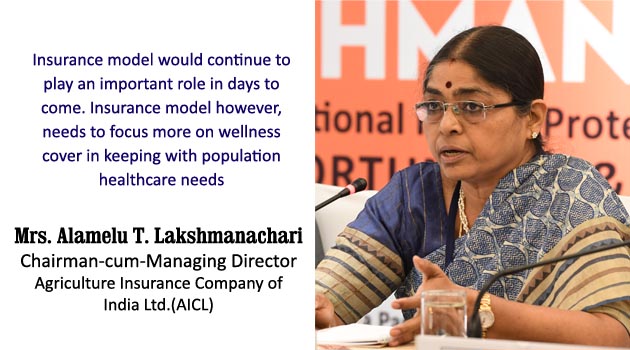 India’s healthcare system like many countries in the world suffers from inverse care and impoverishing care. The deprived population suffers the most in the absence of social protection when confronted with catastrophic healthcare expenses. Mrs. . Lakshmanachari, Chairman-cum-Managing Director of Agriculture Insurance Company of India Ltd.(AICL) observed strongly that insurance model would continue to play an important role in days to come, when asked why most states were going for Trust model instead of Insurance model. “Insurance model,however,needs to focus more on wellness cover in keeping with population healthcare needs.” added AlameluT., who also headed the health portfolio of New India Assurance Co.Ltd as Director and General Manager in her previous assignment. To elucidate her point, she cited the example of the significant progression of Tamil Nadu Chief Minister’s comprehensive health scheme in association with United India Insurance Co.Ltd. The scheme started with the coverage of the BPL people, went on to embrace all state government staff members and also all retired people. The sum insured grew from 30,000 to 1.5 lakh to 3 lakhs. This scheme led to strengthening the Primary Health Centers thus consolidating the entire structure of healthcare.
When asked why the Healthcare system , the key constituent of the architecture of contemporary Indian society, is not performing as it should be, Mr.Denny John, Evidence Synthesis Specialist, Campbell Collaboration pointed out that the time had come to bolster the secondary care along with the primary care . The introduction of Ayushman Bharat will witness manifold increase in the number of healthcare seekers and the resources; and the present structure was just not good enough to meet the needs.
Denny, who is also an Adjunct Scientist with the National Institute of Medical Statistics and Indian Council of Medical Research opined that India’s public health system required to be fortified to meet the increasing healthcare needs of its population. He was pointing out at the challenges that may limit the success of the scheme.
India’s healthcare system like many countries in the world suffers from inverse care and impoverishing care. The deprived population suffers the most in the absence of social protection when confronted with catastrophic healthcare expenses. Mrs. . Lakshmanachari, Chairman-cum-Managing Director of Agriculture Insurance Company of India Ltd.(AICL) observed strongly that insurance model would continue to play an important role in days to come, when asked why most states were going for Trust model instead of Insurance model. “Insurance model,however,needs to focus more on wellness cover in keeping with population healthcare needs.” added AlameluT., who also headed the health portfolio of New India Assurance Co.Ltd as Director and General Manager in her previous assignment. To elucidate her point, she cited the example of the significant progression of Tamil Nadu Chief Minister’s comprehensive health scheme in association with United India Insurance Co.Ltd. The scheme started with the coverage of the BPL people, went on to embrace all state government staff members and also all retired people. The sum insured grew from 30,000 to 1.5 lakh to 3 lakhs. This scheme led to strengthening the Primary Health Centers thus consolidating the entire structure of healthcare.
When asked why the Healthcare system , the key constituent of the architecture of contemporary Indian society, is not performing as it should be, Mr.Denny John, Evidence Synthesis Specialist, Campbell Collaboration pointed out that the time had come to bolster the secondary care along with the primary care . The introduction of Ayushman Bharat will witness manifold increase in the number of healthcare seekers and the resources; and the present structure was just not good enough to meet the needs.
Denny, who is also an Adjunct Scientist with the National Institute of Medical Statistics and Indian Council of Medical Research opined that India’s public health system required to be fortified to meet the increasing healthcare needs of its population. He was pointing out at the challenges that may limit the success of the scheme.
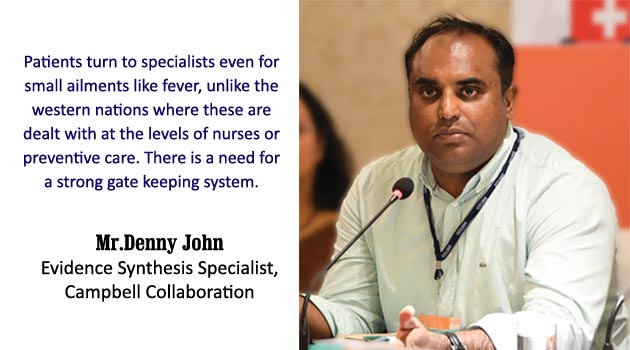 There is acute shortage of specialized doctors in India and adding to the woe, MBBS doctors cannot treat those patients who suffer from the ten most dreaded diseases that most Indians get afflicted with. They may be brilliant doctors but the Hon’ble Supreme court prohibits them from treating these patients on the score of quality of care. Similarly the number of nurses and paramedics need to be increased manifold. The referral system is simply not in place. As a result, patients turn to specialists even for small ailments like fever, unlike the western nations where these are dealt with at the levels of nurses or preventive care. “There is a need for a strong gate keeping system”, opined the panel.
There is acute shortage of specialized doctors in India and adding to the woe, MBBS doctors cannot treat those patients who suffer from the ten most dreaded diseases that most Indians get afflicted with. They may be brilliant doctors but the Hon’ble Supreme court prohibits them from treating these patients on the score of quality of care. Similarly the number of nurses and paramedics need to be increased manifold. The referral system is simply not in place. As a result, patients turn to specialists even for small ailments like fever, unlike the western nations where these are dealt with at the levels of nurses or preventive care. “There is a need for a strong gate keeping system”, opined the panel.
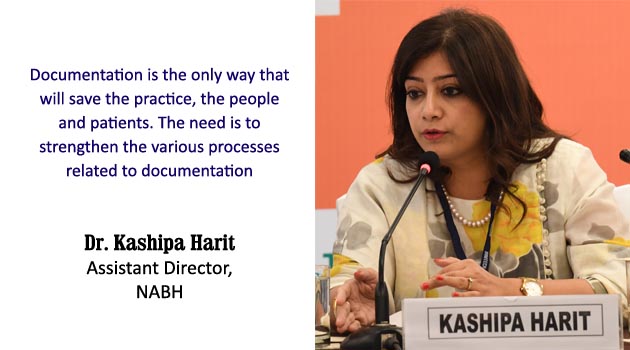 Dr. Kashipa Harit, Assistant Director with NABH lamented the absence of documentation. “We don’t document most of the things in medical management of patients. Documentation is the only way that will save the practice, the people and patients. The need is to strengthen the various processes related to documentation” added Dr.Kashipa.
The accreditation process has been made flexible keeping in mind the growing need of hospitals. The full accreditation has 683 clauses and, therefore, only approximately 700 hospitals have got this accreditation. However, the entry level accreditation has only around 150 clauses and about 1100 hospitals have already got this accreditation.
Dr. Kashipa Harit, Assistant Director with NABH lamented the absence of documentation. “We don’t document most of the things in medical management of patients. Documentation is the only way that will save the practice, the people and patients. The need is to strengthen the various processes related to documentation” added Dr.Kashipa.
The accreditation process has been made flexible keeping in mind the growing need of hospitals. The full accreditation has 683 clauses and, therefore, only approximately 700 hospitals have got this accreditation. However, the entry level accreditation has only around 150 clauses and about 1100 hospitals have already got this accreditation.
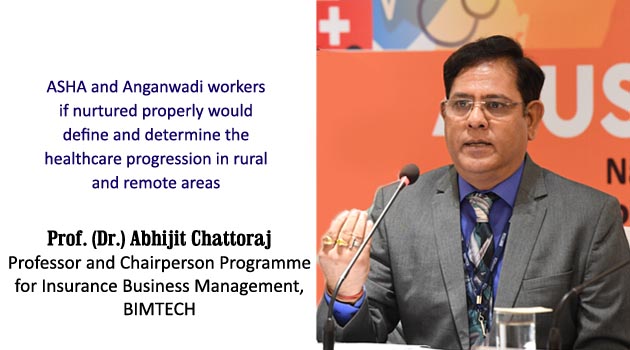 Ms.Malti Jaswal, currently, a senior Consultant with World Bank in India explained, “as the news is spreading, the helpline centers are flooded with thousands of calls as people are curious to know if they are covered; if they are not then how they can be covered. This apart, the beneficiaries can also call the helplines to inquire about availability of beds, treatments and facilities available in their areas. These thousands of calls are indicative of the huge unmet demand in the sector and Ayushman Bharat has given an opportunity to address these demands which in turn would create huge employment opportunity across the entire health eco system
Ms.Malti Jaswal, currently, a senior Consultant with World Bank in India explained, “as the news is spreading, the helpline centers are flooded with thousands of calls as people are curious to know if they are covered; if they are not then how they can be covered. This apart, the beneficiaries can also call the helplines to inquire about availability of beds, treatments and facilities available in their areas. These thousands of calls are indicative of the huge unmet demand in the sector and Ayushman Bharat has given an opportunity to address these demands which in turn would create huge employment opportunity across the entire health eco system
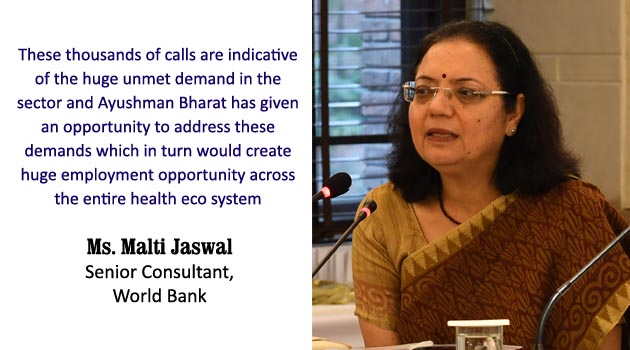
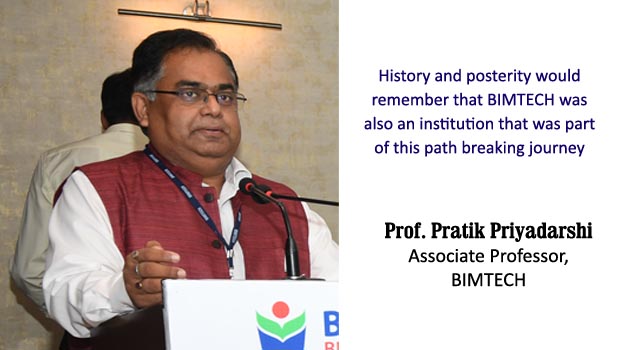 Prof. Pratik Priyadarshi of BIMTECH in his valedictory address, emphasized upon the role of BIMTECH as an institution of reckoning which contributed in its own way towards the vision of Ayushman Bharat. History and posterity would remember that BIMTECH was also an institution that was part of this path breaking journey.
Prof. Pratik Priyadarshi of BIMTECH in his valedictory address, emphasized upon the role of BIMTECH as an institution of reckoning which contributed in its own way towards the vision of Ayushman Bharat. History and posterity would remember that BIMTECH was also an institution that was part of this path breaking journey.
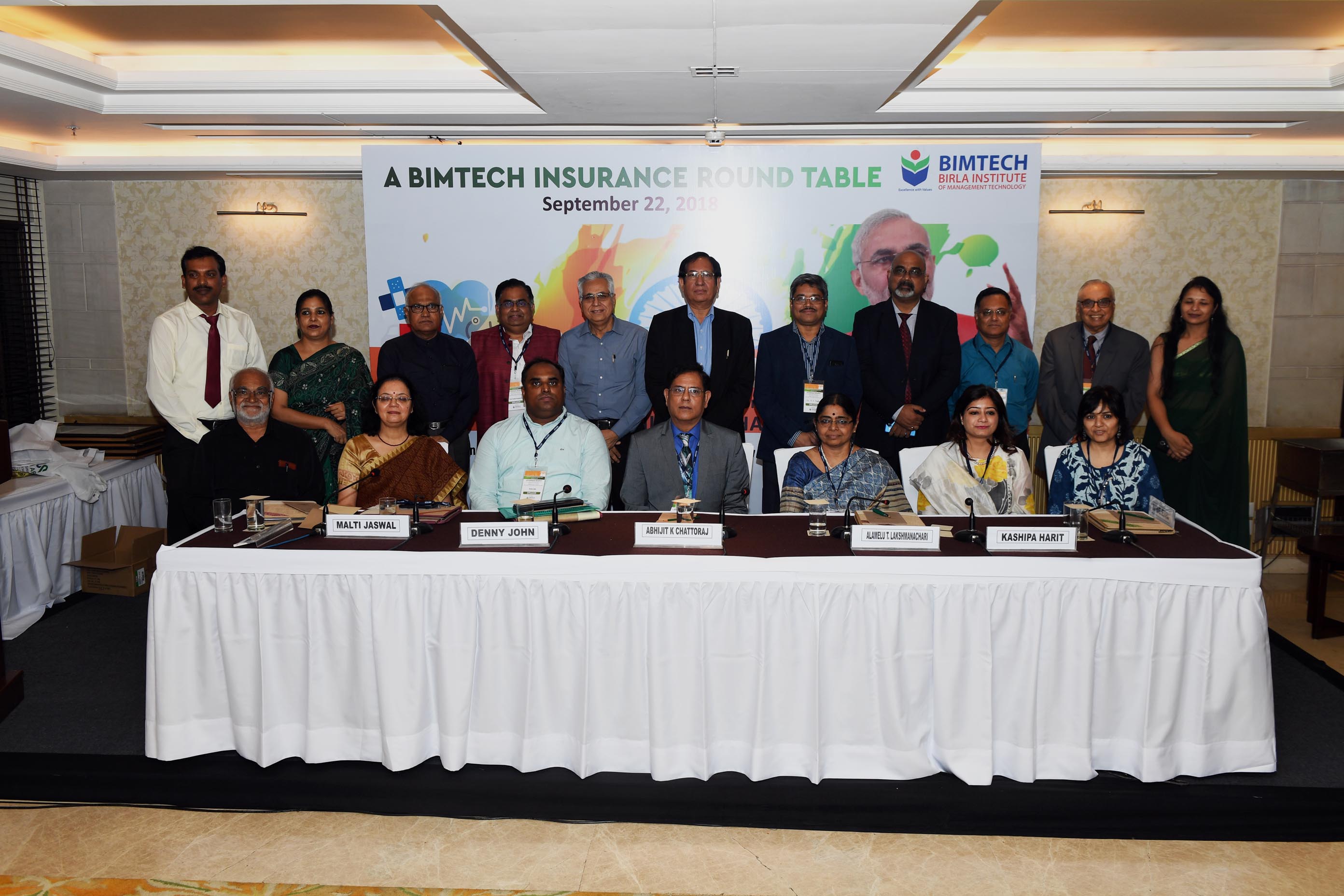
 The thinking behind the round table, said Prof. (Dr) H Chaturvedi, Director, BIMTECH, was to build a consensus around myriads of issues ailing the healthcare system in India. The views of the thought leaders and captains of the healthcare industry participating in the round table would help us in making a blueprint as to how each one of us can contribute towards the vision of Ayushman Bharat. “The foundation of a high-quality health system revolves around the healthcare needs and expectations of the population it serves, the governance of the health sector and effective partnerships across the various key constituents”, he reiterated.
The Scheme aims to adopt a continuum of holistic approach to healthcare comprising two principal pillars – creation of 1.5 lakh health and wellness centers across India and successful implementation of Pradhan Mantri Jan Arogya yojana.
The thinking behind the round table, said Prof. (Dr) H Chaturvedi, Director, BIMTECH, was to build a consensus around myriads of issues ailing the healthcare system in India. The views of the thought leaders and captains of the healthcare industry participating in the round table would help us in making a blueprint as to how each one of us can contribute towards the vision of Ayushman Bharat. “The foundation of a high-quality health system revolves around the healthcare needs and expectations of the population it serves, the governance of the health sector and effective partnerships across the various key constituents”, he reiterated.
The Scheme aims to adopt a continuum of holistic approach to healthcare comprising two principal pillars – creation of 1.5 lakh health and wellness centers across India and successful implementation of Pradhan Mantri Jan Arogya yojana.
 India’s healthcare system like many countries in the world suffers from inverse care and impoverishing care. The deprived population suffers the most in the absence of social protection when confronted with catastrophic healthcare expenses. Mrs. . Lakshmanachari, Chairman-cum-Managing Director of Agriculture Insurance Company of India Ltd.(AICL) observed strongly that insurance model would continue to play an important role in days to come, when asked why most states were going for Trust model instead of Insurance model. “Insurance model,however,needs to focus more on wellness cover in keeping with population healthcare needs.” added AlameluT., who also headed the health portfolio of New India Assurance Co.Ltd as Director and General Manager in her previous assignment. To elucidate her point, she cited the example of the significant progression of Tamil Nadu Chief Minister’s comprehensive health scheme in association with United India Insurance Co.Ltd. The scheme started with the coverage of the BPL people, went on to embrace all state government staff members and also all retired people. The sum insured grew from 30,000 to 1.5 lakh to 3 lakhs. This scheme led to strengthening the Primary Health Centers thus consolidating the entire structure of healthcare.
When asked why the Healthcare system , the key constituent of the architecture of contemporary Indian society, is not performing as it should be, Mr.Denny John, Evidence Synthesis Specialist, Campbell Collaboration pointed out that the time had come to bolster the secondary care along with the primary care . The introduction of Ayushman Bharat will witness manifold increase in the number of healthcare seekers and the resources; and the present structure was just not good enough to meet the needs.
Denny, who is also an Adjunct Scientist with the National Institute of Medical Statistics and Indian Council of Medical Research opined that India’s public health system required to be fortified to meet the increasing healthcare needs of its population. He was pointing out at the challenges that may limit the success of the scheme.
India’s healthcare system like many countries in the world suffers from inverse care and impoverishing care. The deprived population suffers the most in the absence of social protection when confronted with catastrophic healthcare expenses. Mrs. . Lakshmanachari, Chairman-cum-Managing Director of Agriculture Insurance Company of India Ltd.(AICL) observed strongly that insurance model would continue to play an important role in days to come, when asked why most states were going for Trust model instead of Insurance model. “Insurance model,however,needs to focus more on wellness cover in keeping with population healthcare needs.” added AlameluT., who also headed the health portfolio of New India Assurance Co.Ltd as Director and General Manager in her previous assignment. To elucidate her point, she cited the example of the significant progression of Tamil Nadu Chief Minister’s comprehensive health scheme in association with United India Insurance Co.Ltd. The scheme started with the coverage of the BPL people, went on to embrace all state government staff members and also all retired people. The sum insured grew from 30,000 to 1.5 lakh to 3 lakhs. This scheme led to strengthening the Primary Health Centers thus consolidating the entire structure of healthcare.
When asked why the Healthcare system , the key constituent of the architecture of contemporary Indian society, is not performing as it should be, Mr.Denny John, Evidence Synthesis Specialist, Campbell Collaboration pointed out that the time had come to bolster the secondary care along with the primary care . The introduction of Ayushman Bharat will witness manifold increase in the number of healthcare seekers and the resources; and the present structure was just not good enough to meet the needs.
Denny, who is also an Adjunct Scientist with the National Institute of Medical Statistics and Indian Council of Medical Research opined that India’s public health system required to be fortified to meet the increasing healthcare needs of its population. He was pointing out at the challenges that may limit the success of the scheme.
 There is acute shortage of specialized doctors in India and adding to the woe, MBBS doctors cannot treat those patients who suffer from the ten most dreaded diseases that most Indians get afflicted with. They may be brilliant doctors but the Hon’ble Supreme court prohibits them from treating these patients on the score of quality of care. Similarly the number of nurses and paramedics need to be increased manifold. The referral system is simply not in place. As a result, patients turn to specialists even for small ailments like fever, unlike the western nations where these are dealt with at the levels of nurses or preventive care. “There is a need for a strong gate keeping system”, opined the panel.
There is acute shortage of specialized doctors in India and adding to the woe, MBBS doctors cannot treat those patients who suffer from the ten most dreaded diseases that most Indians get afflicted with. They may be brilliant doctors but the Hon’ble Supreme court prohibits them from treating these patients on the score of quality of care. Similarly the number of nurses and paramedics need to be increased manifold. The referral system is simply not in place. As a result, patients turn to specialists even for small ailments like fever, unlike the western nations where these are dealt with at the levels of nurses or preventive care. “There is a need for a strong gate keeping system”, opined the panel.
 Dr. Kashipa Harit, Assistant Director with NABH lamented the absence of documentation. “We don’t document most of the things in medical management of patients. Documentation is the only way that will save the practice, the people and patients. The need is to strengthen the various processes related to documentation” added Dr.Kashipa.
The accreditation process has been made flexible keeping in mind the growing need of hospitals. The full accreditation has 683 clauses and, therefore, only approximately 700 hospitals have got this accreditation. However, the entry level accreditation has only around 150 clauses and about 1100 hospitals have already got this accreditation.
Dr. Kashipa Harit, Assistant Director with NABH lamented the absence of documentation. “We don’t document most of the things in medical management of patients. Documentation is the only way that will save the practice, the people and patients. The need is to strengthen the various processes related to documentation” added Dr.Kashipa.
The accreditation process has been made flexible keeping in mind the growing need of hospitals. The full accreditation has 683 clauses and, therefore, only approximately 700 hospitals have got this accreditation. However, the entry level accreditation has only around 150 clauses and about 1100 hospitals have already got this accreditation.
Unfolding Opportunities
National Health Agency (NHA) like NHS of UK has the potential to emerge as the biggest employer in India. The healthcare boundary would expand with the growth of this scheme leading to generation of a pool of employment opportunities as there would be a need of a huge number of medical staff – especially the paramedics and skilled health workers to execute the programme. The experiment of ASHA and Anganwadi workers in rural India has really been very rewarding and the Hon’ble Prime Minister recently recognised their yeoman services by way of hiking their salaries. “ASHA and Anganwadi workers if nurtured properly would define and determine the healthcare progression in rural and remote areas”, observed Prof. (Dr.) Abhijit Chattoraj of BIMTECH. Ms.Malti Jaswal, currently, a senior Consultant with World Bank in India explained, “as the news is spreading, the helpline centers are flooded with thousands of calls as people are curious to know if they are covered; if they are not then how they can be covered. This apart, the beneficiaries can also call the helplines to inquire about availability of beds, treatments and facilities available in their areas. These thousands of calls are indicative of the huge unmet demand in the sector and Ayushman Bharat has given an opportunity to address these demands which in turn would create huge employment opportunity across the entire health eco system
Ms.Malti Jaswal, currently, a senior Consultant with World Bank in India explained, “as the news is spreading, the helpline centers are flooded with thousands of calls as people are curious to know if they are covered; if they are not then how they can be covered. This apart, the beneficiaries can also call the helplines to inquire about availability of beds, treatments and facilities available in their areas. These thousands of calls are indicative of the huge unmet demand in the sector and Ayushman Bharat has given an opportunity to address these demands which in turn would create huge employment opportunity across the entire health eco system

Technology – The disruptor
The scheme needs to sharpen its focus on data. The role of Health Technology Assessment (HTA) is very important for sustaining a scheme of this size. Many countries are seizing the opportunity of Pay-for-Performance to upgrade their health data system with increasing granularity, transparency and versatility. Taking the magnitude into consideration, technology alone can play a pivotal role in bridging the supply and demand. Ayushman has created phone lines, national call centers, activation codes for enrollment, website, and online database for vacancies to smoothen the process. Better communication will facilitate high-tech methods to cure diseases reach to all the health centers. Improved technology has also simplified the registration process. The patients can just walk into the health centers with any government identification card and avail the medical facilities. The website also plays a major role when it comes to awareness. The website provides all information related to the processes under the scheme – be it registration processes, facilities, details on coverages or measures for fraud management.Quality – the game changer
“The quality of healthcare is another challenge in India. There is absence of evidence based medicine or treatment. India also should develop an institute on the line of National Institute of Health and clinical excellence (NICE, UK) that can develop clinical guidance-based on relevance evidence of clinical effectiveness and cost effectiveness. NICE also disseminate information about clinical audit methodologies and uses complex systems like Quality Adjusted Life Years(QALY)to measure length and quality of life The National Institute of Excellence (NIE) is a good initiative undertaken by National Health Agency (NHA)”, observed Prof. (Dr.) Abhijit Chattoraj, the moderator of the round table. Most panelists concurred that Ayushman can transform the nation’s healthcare landscape if it can overcome challenges arising out of shortages of medical staff and infrastructure, fraudulent claims, corruption within and outside medical boundaries and above all lack of awareness. The focus should be to build a robust and resilient Public Health system. Prof. Pratik Priyadarshi of BIMTECH in his valedictory address, emphasized upon the role of BIMTECH as an institution of reckoning which contributed in its own way towards the vision of Ayushman Bharat. History and posterity would remember that BIMTECH was also an institution that was part of this path breaking journey.
Prof. Pratik Priyadarshi of BIMTECH in his valedictory address, emphasized upon the role of BIMTECH as an institution of reckoning which contributed in its own way towards the vision of Ayushman Bharat. History and posterity would remember that BIMTECH was also an institution that was part of this path breaking journey.


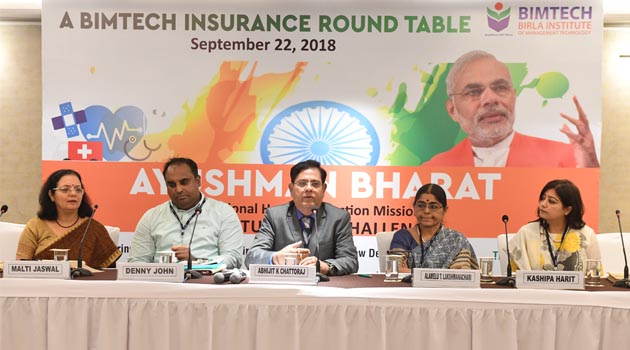


Leave a Reply